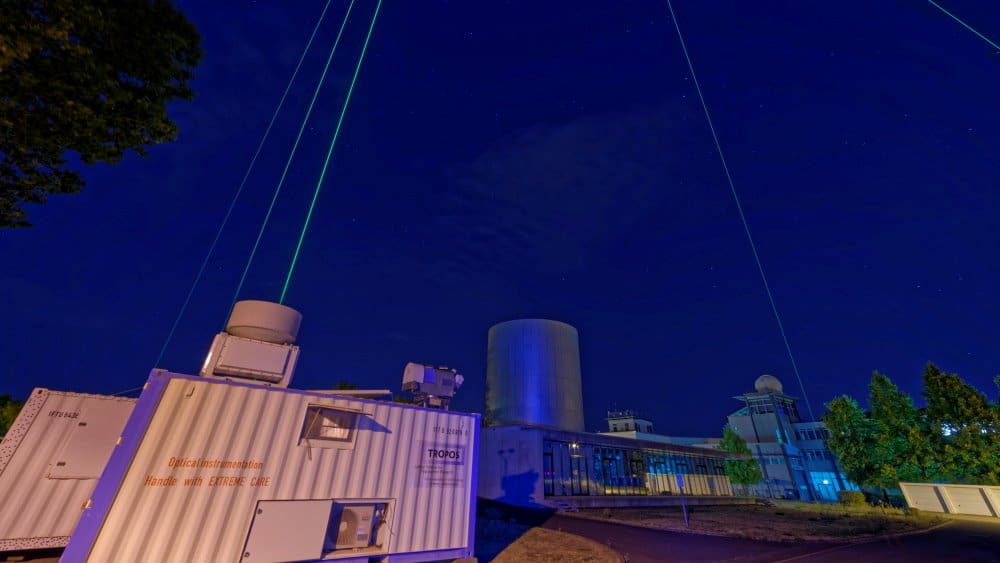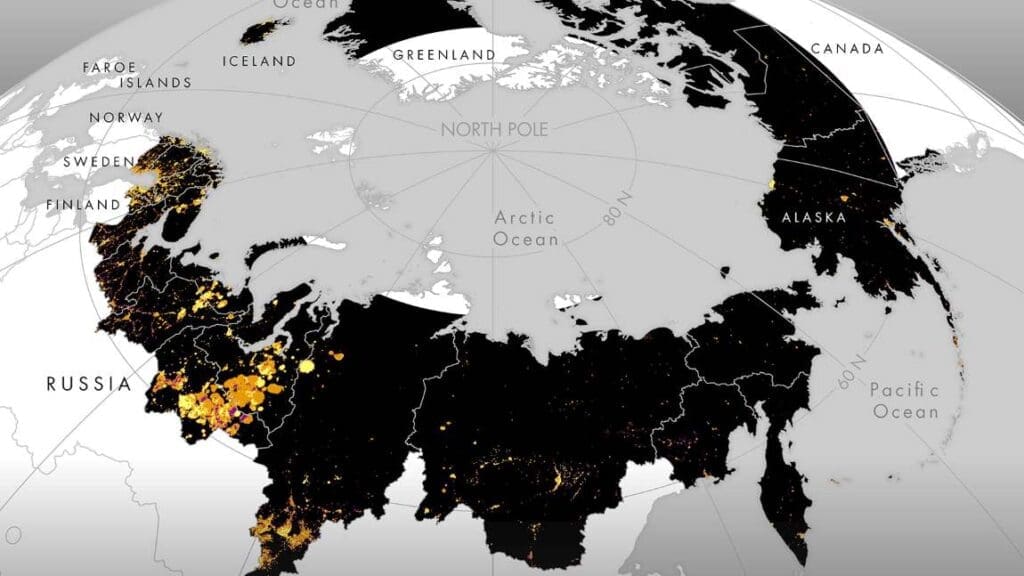Explore the latest insights from top science journals in the Muser Press daily roundup (August 25, 2025), featuring impactful research on climate change challenges.
In brief:
In Africa, heatwaves are hotter and longer than 40 years ago, UIC researchers say
Heatwaves – prolonged periods of abnormally hot weather – influence egg prices, energy bills and even public transit. And they’re becoming more common as temperatures increase.
In a new study, published in Communications Earth & Environment, UIC researchers report that heatwaves across Africa are hotter, longer and more frequent today than 40 years ago, mainly due to increased greenhouse gas and black carbon emissions from burning fossil fuels. Understanding heatwaves’ origins and effects can help African countries predict them and adapt.
“Raising awareness of heatwaves is critical to saving human life,” said Akintomide Afolayan Akinsanola, head of the Climate Research Lab and assistant professor of earth and environmental sciences in the UIC College of Liberal Arts and Sciences. “In a developing continent like Africa, where the capacity for adaptive infrastructure is relatively low, heatwaves can have greater consequences.”
Africa is uniquely vulnerable to heatwaves in an already warming world; in April 2024, temperatures in the West African city of Kayes exceeded 119 degrees Fahrenheit (48.3 °C). Heatwaves harm ecosystems, reduce agricultural productivity and strain energy systems. Infants, older adults and those with health conditions are especially susceptible to heat-related illness, which kills 5,600 people annually in the U.S. Some experts have estimated that heat-related deaths in Nigeria may rise to 23,000 or even 43,000 per year by the end of the 21st century.
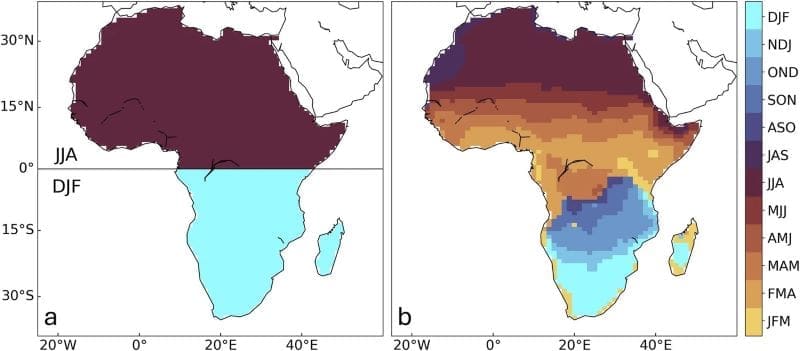
But climate extremes in Africa and its subregions are understudied due to insufficient computing infrastructure and a lack of data and resources, the researchers said. Filling this knowledge gap could protect people living in these regions and help forecast similar scenarios around the globe.
Akinsanola and his team examined the intensity, frequency and duration of heatwaves in Africa during two periods: 1950-1979 and 1985-2014. The researchers used large-ensemble computer models to isolate the factors contributing to daytime, nightime and compound heatwaves, including human-driven influences like greenhouse gas and aerosol emissions as well as natural variability.
The researchers saw stark differences between the two periods they studied. The 1950-1979 period was characterized by weak, infrequent heatwaves, with about one occurring every three to eight years. About 80% of heatwave activity during this time could be attributed to natural causes, and the researchers highlighted the cooling effects of sulfate aerosol: airborne sulfur particles caused naturally by volcanic eruptions or anthropogenically through fossil fuel burning make clouds reflect more light back into space.
In contrast, the 1985-2014 period saw one or more heatwaves every two years, lasting up to three times as long as in the previous period. These changes were mainly due to human activities like increased greenhouse gas and black carbon emissions. In this period, the researchers attributed only 30% of heatwave activity to natural causes.
The team also identified a strong correlation between heatwave frequency and near-surface air temperature, likely due to shared variables like air circulation and surface energy.
“I was surprised to see that these changes were consistent across the African subregions, not just a specific isolated area,” said Vishal Bobde, a doctoral student in Akinsanola’s lab and the study’s first author.
The authors hope their findings will help policymakers, scientists, government officials and African communities develop effective mitigation and adaptation strategies for heatwaves, such as strengthening early-warning systems and improving heat-risk literacy.
“The impacts are wide-ranging, from productivity to food shortage to energy,” said Akinsanola, who is jointly appointed at the Environmental Science Division of Argonne National Laboratory. “Remember that the African population is close to 2 billion. Heatwaves can lead to drought, trigger migration and spark conflicts, thereby impacting regional, continental and even global stability.”
Looking ahead, the researchers plan to investigate how projections for future heatwaves might change based on global adherence to the goals set in the 2015 Paris Agreement.
“While Africa contributes a relatively small share of global greenhouse gas emissions, climate change is a global issue that is intensifying heatwaves everywhere. Addressing this requires global cooperation to aggressively reduce emissions and build adaptive capacity,” said Kayode Ayegbusi, co-first author and UIC doctoral student in Akinsanola’s lab.
Institutional collaborators include The Australian National University, Texas A&M and the University of California, Merced.
The researchers used Community Earth System Model 2 – Large Ensemble simulations, which are managed by the National Center for Atmospheric Research and are publicly available through the Earth System Grid Federation or NCAR Climate Data Gateway.
Journal Reference:
Bobde, V., Ayegbusi, K., Akinsanola, A.A. et al., ‘Anthropogenic warming is accelerating recent heatwaves in Africa’, Communications Earth & Environment 6, 578 (2025). DOI: 10.1038/s43247-025-02578-6
Article Source:
Press Release/Material by University of Illinois Chicago
Researchers identify increased microbial carbon use efficiency upon abrupt permafrost thaw
Thawing permafrost is a major climate risk due to the associated release of carbon dioxide and other greenhouse gases (GHGs). However, new research by a team led by Prof. Yang Yuanhe from the Institute of Botany of the Chinese Academy of Sciences shows how microbes can stabilize soil carbon and potentially weaken the climate risk.
In a new study published in PNAS, the researchers provide compelling evidence that microbial carbon use efficiency (CUE) – the proportion of carbon uptake used for microbial growth – rises following abrupt permafrost thaw.
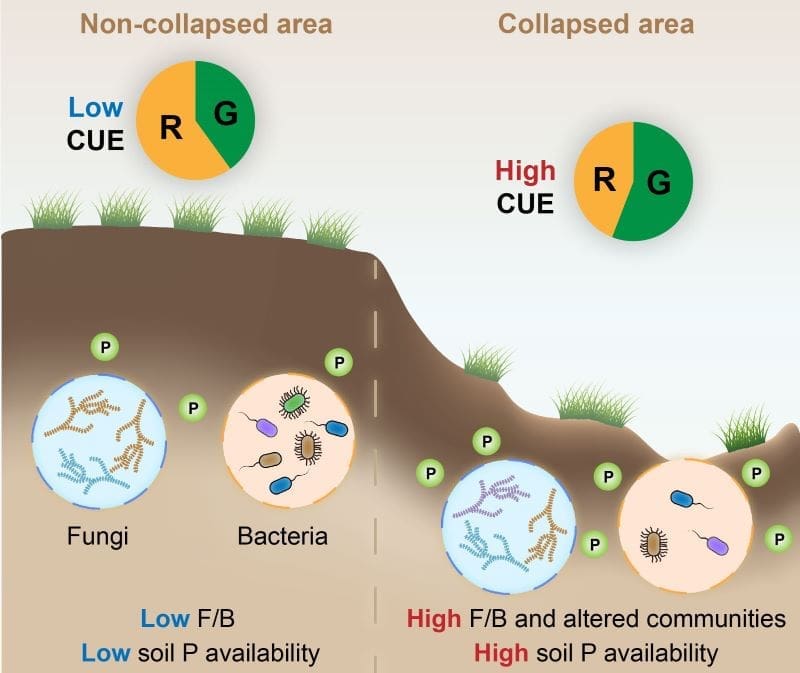
Using a substrate-independent 18O-tracing approach, the researchers examined how microbial CUE changes after abrupt permafrost thaw. They collected topsoil samples representing the permafrost thaw sequence – i.e., the different phases of the thawing process – as well as samples from five additional thaw-affected sites on the Tibetan Plateau.
The results from both the thaw sequence and the regional sites consistently revealed that microbial CUE increased after permafrost thaw, demonstrating the generality of the finding.
Further analysis indicated that this rise in microbial CUE was largely driven by shifts in microbial community composition, including a higher fungal-to-bacterial biomass ratio and a greater prevalence of fast-growing taxa in thawed soils. Increased availability of soil phosphorus upon thawing also provided microbes with essential nutrients, thereby supporting growth and enhancing CUE.
Traditionally, abrupt permafrost thaw has been considered a major source of GHG emissions, accelerating carbon–climate feedback. However, the observed increase in microbial CUE may promote the incorporation of microbial-derived compounds into the soil, fostering the formation of stable soil carbon and potentially mitigating the intensity of carbon–climate feedback.
This study sheds light on how abrupt permafrost thaw affects microbial CUE and highlights the critical role of microbial physiology in determining the fate of permafrost carbon.
Journal Reference:
S. Qin,G. Wang,D. Zhang, & Y. Yang, ‘Increased microbial carbon use efficiency upon abrupt permafrost thaw’, Proceedings of the National Academy of Sciences U.S.A. 122 (33) e2419206122 (2025). DOI: 10.1073/pnas.2419206122
Article Source:
Press Release/Material by Chinese Academy of Sciences (CAS)
Will climate change promote the spread of Dengue fever through Western Europe?
Most people recover from Dengue fever, which is caused by a virus transmitted from the Asian tiger mosquito, but some infected individuals experience serious bleeding, a sudden drop in blood pressure, and even death.
Although Dengue fever has long been recognized as a disease of the tropics and sub-tropics, a study published in Global Change Biology reveals that it is likely to spread increasingly northward and through Western Europe as climate change expands the Asian tiger mosquito’s habitat.
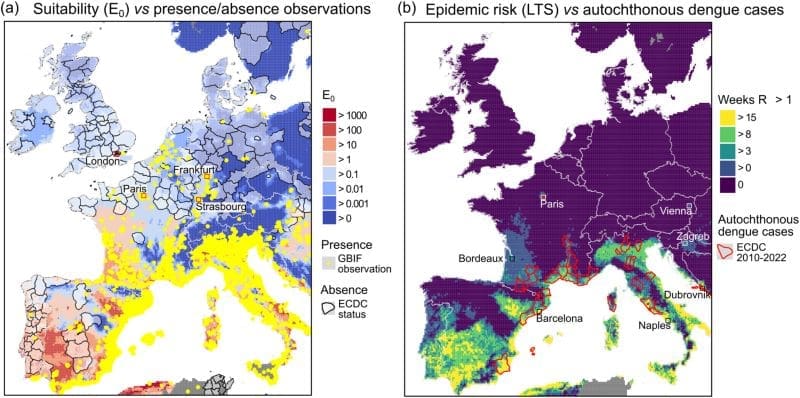
The mosquito lays its eggs in water where, with sufficient temperature, larvae develop and give rise to flying bloodsucking adults. After arriving in Albania, in Southeast Europe, in 1979, it spread through Southwest Europe and now is expanding northward in France. Using modeling and observations of recent spread, investigators determined that with climate change conditions, major Western European cities – including London, Vienna, Strasburg, and Frankfurt – would be well suited to the Asian tiger mosquito.
The team notes that although the mosquito is not in these cities yet, its rate of northward spread in France has been accelerating from about 6 km per year in 2006 to 20 km per year in 2024.
“Extrapolating from the results, it is estimated that the mosquito could establish itself in northern France within a decade, from where it could easily reach London – which is already climatically suitable for hosting this vector,” said corresponding author Andrea Radici, PhD, of the Université de Montpellier, in France.
In addition to Dengue fever, the Asian tiger mosquito also transmits Zika and chikungunya.
Journal Reference:
Radici, A., P. Hammami, A. Cannet et al., ‘Aedes albopictus Is Rapidly Invading Its Climatic Niche in France: Wider Implications for Biting Nuisance and Arbovirus Control in Western Europe’, Global Change Biology 31, 8: e70414 (2025). DOI: 10.1111/gcb.70414
Article Source:
Press Release/Material by Wiley
Earth System Models project the start of the Amazon dieback within the 21st century
The Amazon is the world’s largest rainforest. It harbors immense biodiversity and plays a crucial role in the global climate system by storing vast amounts of carbon in its vegetation. The Amazon is widely recognized as a major climate tipping element. Continued deforestation and climate change could push the system past a critical threshold, causing the Amazon to shift from rainforest rich in biodiversity to a degraded savannah-like ecosystem.
A new study, published in Communications Earth & Environment, explores long-term future projections of the Amazon ecosystem using state-of-the-art Earth System Models.
Researchers assessed long-term changes in the Amazon rainforest from the present through the year 2300 using the state-of-the-art Earth System Models from the Coupled Model Intercomparison Project (CMIP5 and CMIP6), which informed the IPCC’s Fifth and Sixth Assessment Reports. They defined “dieback” as severe loss of photosynthetic activity by the end of the 23rd century compared to the 19th century in areas that were originally highly productive, under, under high-emission scenarios. The scientists then analyzed the climatic and ecological conditions under which such drastic shifts could occur.
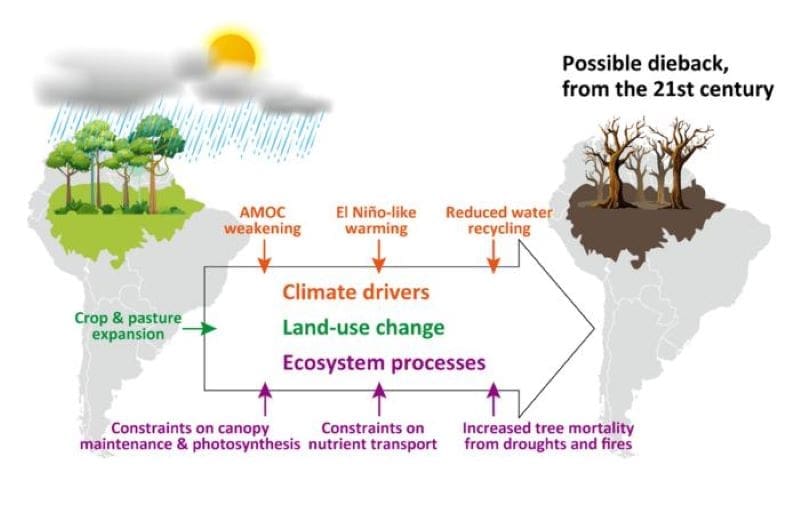
The majority of considered models project Amazon dieback, although the timing and spatial extent vary across models. The results of Earth System Model simulations suggest that the dieback could begin as early as the 21st century under a wide range of global warming levels, starting from 1.5°C and triggered by extreme conditions – large increases in the annual surface air temperatures, decreases in precipitation and intensified by land-use change from forest to agricultural lands.
However, current Earth System Models may underestimate future risks, as many do not fully represent key ecological processes in tropical forests, such as fire dynamics and drought-induced tree mortality.
The new study also uncovers the key mechanisms behind Amazon dieback. Over the long term, global warming weakens the Atlantic Meridional Overturning Circulation (AMOC), a major system of ocean currents, which in turn shifts the Intertropical Convergence Zone (a vital tropical rain belt) southward. This shift results in hotter and drier conditions across the northern Amazon. Furthermore, rising carbon dioxide levels reduce evapotranspiration, the process by which trees release moisture into the air, thereby weakening the Amazon’s natural water recycling system and contributing to regional drying.
In addition, long-term projections under high-emission scenarios show more frequent El Niño–like warming patterns, which intensify heat and drought across the basin. While previous studies have examined warming patterns, circulation shifts and ecosystem impacts, this study is the first to demonstrate Amazon dieback across multiple Earth System Model projections and to explain its underlying drivers.
These climatic changes set off a cascade of ecological disruptions. Hotter and drier conditions reduce the efficiency of photosynthesis and increase plant respiration, tipping the rainforest’s carbon balance. Declining rainfall and soil moisture limit water availability and hinder nutrient transport, stressing tree health and regeneration.
As a result, tropical forest ecosystems become less productive, more vulnerable to disturbance, and eventually cross a threshold beyond which they can no longer sustain dense vegetation. Combined with widespread land-use change, especially in the southern Amazon, these shifts push the region toward large-scale ecosystem collapse.
The study’s findings highlight the urgent need to limit greenhouse gas emissions and protect the Amazon’s resilience. Continued warming, land-use change, and ecosystem degradation could soon push the rainforest past a tipping point, with global climate consequences.
The lead author Dr. Irina Melnikova, also cautions that future research should focus on improving the representation of ecological processes in models to better anticipate the risks. Protecting the Amazon requires coordinated international action, integrating climate mitigation, sustainable land management, and conservation strategies.
Journal Reference:
Melnikova, I., Hajima, T., Shiogama, H. et al., ‘Amazon dieback beyond the 21st century under high-emission scenarios by Earth System models’, Communications Earth & Environment 6, 670 (2025). DOI: 10.1038/s43247-025-02606-5
Article Source:
Press Release/Material by National Institute for Environmental Studies (NIES), Japan
Featured image credit: Gerd Altmann | Pixabay


